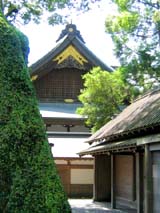|
|
|
|
 |
|
JAPAN: Shintos commit to sustainable management of sacred forests
In 2007 Jinja Honcho, the Association of Shinto shrines in Japan, agreed to work with other faiths to develop a set of Religious Management Standards for religious-owned forests. Details of this, and links to further background pages can be found by linking to our Religious Forestry Standard section.
 |
 |
 |
Part of the Ise Grand Shrines |
The initiative follows on from a pledge made in 2000, under the aegis of WWF and ARCs' Sacred Gifts programme, when Japan’s Shinto leaders pledged not only to manage all of their sacred forests in sustainable ways but also only to buy timber from sustainably managed forests on behalf of their 80,000 or more shrines. Link here for some background information about Shinto forests and here to learn specifically about the Great Shrines of Ise.
As a Sacred Gift this original initiative was important both to Japan and to the endangered forests of SE Asia.
The Gift reflected the Shinto culture’s reverence for nature, and particularly for trees and woodlands. Thousands of Shinto shrines in Japan are built largely of wood and these shrines form the heart of the villages and local communities of Japan. Often the only extensive areas where trees and greenery flourish in Japanese cities and towns are in holy shrines. Here the faith controls the land and is able to practice what it teaches about the sacred nature of all life.
According to custom, the Shinto shrines at Ise are ritually rebuilt every 20 to 25 years – with the wood coming either from local forests or bought from outside. As part of this Gift, the Association of Shinto Shrines, Jinja Honcho, has now requested that the wood for shrines conforms to sustainable forestry standards.
Since most of this wood comes from countries outside Japan, this increase in consumer demand is likely to have a significant effect on Japanese companies buying wood from abroad.
|
 |
|
|
|
|
|
 |
Ise Grand Shrines
The Ise Grand Shrines are unique because, in addition to some 5,500 hectares of sacred forest, they are also surrounded by a vast area of forest covering the nearby mountains. This article gives detailed background to Ise's surrounding forests. |
 |
September 24, 2007:
Ancient Yews celebrated in new book
Three ancient yews in a Northumberland churchyard, one of which is said to have protected St Cuthbert when he preached underneath it in the seventh century, have inspired a new book of writing and poetry written by the visually impaired. |
 |
Shinto Forestry
It is the forests, and not the buildings, that mark the true shrines of Shintoism. The deities are invited to these forests, where they and their environment are protected by the local community, which in turn is protected by the deities. |
 |
 |
|
|

